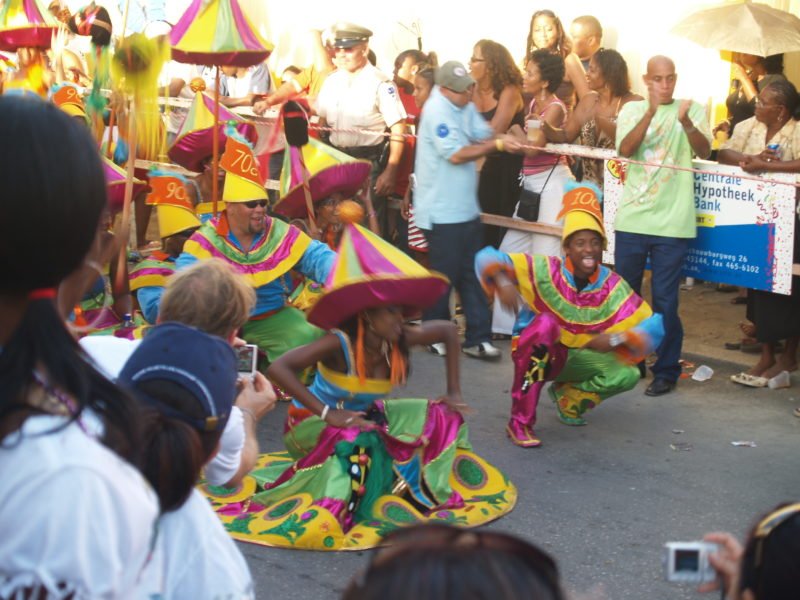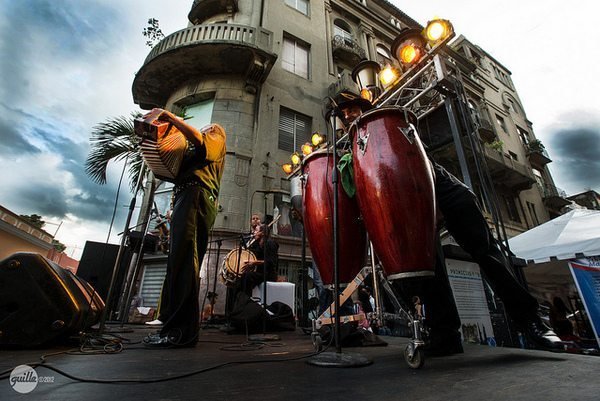Caribbean Carnival: Curacao
I know I danced for hours, but I also know how far I danced: Four miles, to be exact and receiving high-fives and drinks all along the way.
Carnival in many parts of the world is a party extraordinaire with colorful parades and festivities leading up to Ash Wednesday, the start of the Christian pre-Easter period of fasting known as Lent. Revelers gather to drink and dance and watch parades full of elaborate floats. Why just be a spectator, I figure? I went to Curacao to actually be in the parade.
Located in the southern Caribbean Sea thirty-seven miles north of Venezuela, Curacao (pronounced cure-a-SOW) was the largest island of the Netherlands Antilles. Now it’s independent. Its capital, Willemstad, looks like a misplaced Amsterdam splashed with Caribbean color. 17th and 18th-century colonial buildings overlook the harbor which divides the city in two sections-Punda and Otrobanda-connected by the Queen Emma pontoon bridge. Both sections provide visitors with excellent duty-free shopping and local culture while watersports and gorgeous beaches lie just a bit farther afield.
See The Mad Traveler Curacao Carnival video
But all this takes a back seat to Carnival. Its local history dates back to private masquerade parties in the 19th century, but by the 1970s the event had transformed to a popular island-wide celebration. In 2007, Carnival groups started allowing travelers to leave the sidelines and be a bigger part of the fun.

I had signed up with Taki Tin, the largest of the Carnival groups (and perhaps the least organized, which kept this fun). When I arrived on the island two days before the Gran Marcha parade, the group’s seamstress greeted me and several other visiting participants in her own home where we took turns trying on our costumes. I had emailed my measurements several weeks in advance. Most of the costumes were spot on; others needed some quick alterations but then we were off. We had to leave our shoes for final decoration and pick them up later. Word of advice: bring shoes you never want to see again. In many cases the costume designers use a glue that is difficult to get off.
Then on Sunday we gathered for a hearty buffet breakfast at a pavilion at 10 a.m. where make-up artists laid on the finishing touches. The 200 or so members of Taki Tin piled into school buses which took us to the starting point of the parade which passes through Otrabanda on a different route every year.

There were 31 floats complete with bands, costumed marching dancers, and dedicated beverage servers who thread their way through the groups handing out plenty of water, vodka, whisky and rum drinks as well as an assortment of finger food. The music started and for the next four miles-and over five hours-never stopped as we shuffled along the route in our costumes to the cheers of onlookers. Earplugs are definitely advisable, especially if you want to walk close to the bandwagon.
Being in a local group was a much more engaging Carnival experience, but there is another advantage to celebrating in Curacao: this is not the kind of Carnival where I felt I needed to have my pockets sewn shut with barbed wire or where screaming drunk revelers falling all over me and spilling their drinks was the norm. There is plenty of carousing, to be sure, but it is a good-natured crowd and overall the event is even family-friendly.
The lead-up to Carnival starts over one month in advance and includes various parties called jump-ups and a four-day music festival where local tumba bands and composers compete to have their song selected as the official march. The warm-up also includes Children’s Carnival and the election of the Carnival Queen. But the events not to miss are the two parades: Sunday’s Gran Marcha and Marcha Despidida (the Farewell March) on the evening before Ash Wednesday. The latter brings lights and sparklers to the floats and ends with the burning of King Momo, an enormous straw effigy representing infertility, bad luck and bad behavior. It’s a spectacle for sure and accompanied by fireworks.
On Tuesday evening, after exhausting ourselves with another parade of song, dance and drink, we gathered to watch as King Momo lit up the sky.
See The Mad Traveler Curacao Carnival video
The Details
Prices range from $400 USD to over $1000, much of the variation having to do with included meals and the complexity of the costumes. Some groups require an early arrival for rehearsal. Taki Tin was more laid back, unrehearsed, and charged $417 (in 2007) which was the most common price tag. The price included transportation to both parades, two breakfasts and dinners, snacks and all drinks, and of course a fitted costume. And don’t worry- these are not the kind of Carnival costumes you pick up in an envelope.
Not interested in the long march? Sign on with the Curacao Tourism booth for a modest fee and enjoy food, drink, and a front row bleacher view of the parade route.
The Gran Marcha for Curacao Carnival 2012 will be February 19th.
For more information go to http://www.curacaocarnival.info/
Live web cam: http://www.liveincuracao.com/webcam.php





 ORDER YOUR COPY TODAY!
ORDER YOUR COPY TODAY! ORDER YOUR COPY TODAY!
ORDER YOUR COPY TODAY!
Pingback: Carnival in Curacao (Video)
Pingback: Interview: Johnny Jet Goes on The Travel Channel
Pingback: Travel Photo of the Week: Willemstad, Curacao
Pingback: Travel Photo of the Week: Carnival Masks in Venice